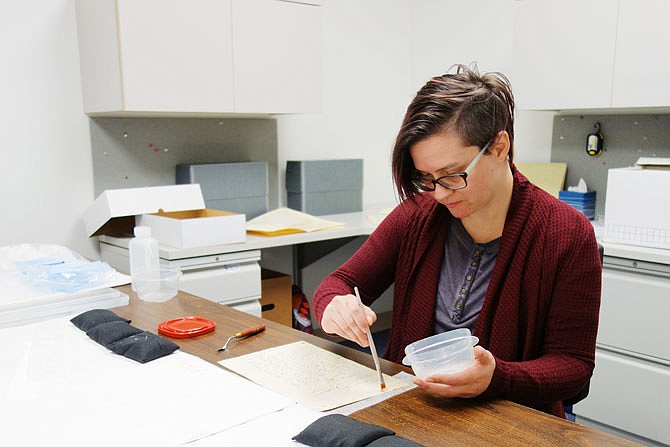Individually, the boxes of old circuit court records aren't too exciting.
But taken together, they may one day provide insights into the daily life of Callawegians in the 1800s: their jobs, their troubles, even their mere existence. But before they can be useful to researchers, dozens upon dozens of stacks of files must be teased apart, cleaned and recorded on microfilm. That's where Missouri State Archives field archivist Lisa Janes comes in.
"I'm processing circuit court case files," Janes explained, taking a brief break from work earlier this week. "This box is from the 1840s to the 1860s; all of these are pre-1900 case files."
Janes has been stationed in her own office at the Kingdom of Callaway Historical Society's new 4th Street Research Center since it opened this summer. Before that, she had part-time use of a single folding table in a back room at the Society's museum.
"Other people used that table, too, so I'd have to pack all the supplies and files up at the end of the day," Janes remembered ruefully.
Being able to use a more spacious office at the new building allowed her to bring in interns over the summer. That, along with not having to pack everything away every day, has allowed her work to move more quickly.
And it's a lot of work. Janes' job is to prepare the records to be scanned at the Missouri State Archives office. At more than 100 years old, these documents are fragile and often rumpled; any crease may become a rip if not handled with care. The flowing handwriting favored by the 1800s may make it hard to decipher dates. Some pages are coated with grime, or, worse, stuck together with ancient glue.
Janes has techniques to deal with each scenario. She demonstrated how to unstick pages, using a paintbrush to distribute a clear, viscous substance across the spot where two pages adhere.
"This is methyl cellulose, which is a type of glue," Janes said. "It soaks into where the old glue is and loosens it up, so I can separate the pages with a spatula."
After all that is complete, she sends each batch to the imaging department at the Archives; in turn, they scan the records onto microfilm and send a user-friendly PDF copy back to the Society.
When the research center first opened back in July, Society museum director Barbara Huddleston emphasized the value of preserving these old records. Missouri didn't have official birth and death certificates until 1910, Huddleston explained.
"There's a chance the only time someone was ever mentioned in a document is in the circuit court records, so they're quite important," she said.
Janes became interested in archival work while working on a bachelor degree in history at Northwest Missouri State University; her degree involved doing an internship in the university's archives.
"I fell into it," she said.
She later became a library technician for CoxHealth.
"I worked in the medical library they have in Springfield and had to figure out what to do with all of that historical material," Janes said.
That experience qualified her for the field archivist job, which she took in 2016. She has also completed a master's degree in library and information sciences.

